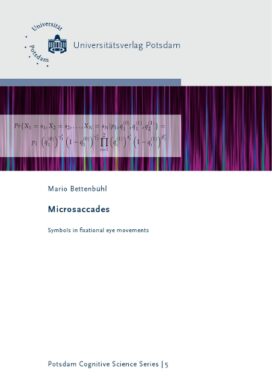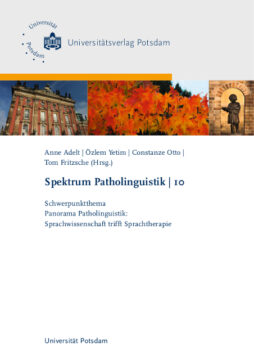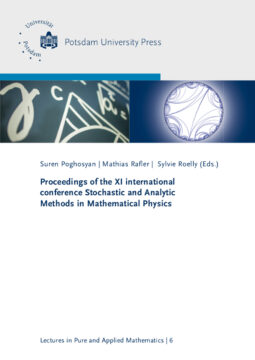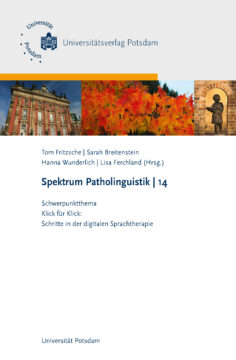The first thing we do upon waking is open our eyes. Rotating them in our eye sockets, we scan our surroundings and collect the information into a picture in our head. Eye movements can be split into saccades and fixational eye movements, which occur when we attempt to fixate our gaze. The latter consists of microsaccades, drift and tremor. Before we even lift our eye lids, eye movements – such as saccades and microsaccades that let the eyes jump from one to another position – have partially been prepared in the brain stem. Saccades and microsaccades are often assumed to be generated by the same mechanisms. But how saccades and microsaccades can be classified according to shape has not yet been reported in a statistical manner. Research has put more effort into the investigations of microsaccades’ properties and generation only since the last decade. Consequently, we are only beginning to understand the dynamic processes governing microsaccadic eye movements. Within this thesis, the dynamics governing the generation of microsaccades is assessed and the development of a model for the underlying processes. Eye movement trajectories from different experiments are used, recorded with a video-based eye tracking technique, and a novel method is proposed for the scale-invariant detection of saccades (events of large amplitude) and microsaccades (events of small amplitude). Using a time-frequency approach, the method is examined with different experiments and validated against simulated data. A shape model is suggested that allows for a simple estimation of saccade- and microsaccade related properties. For sequences of microsaccades, in this thesis a time-dynamic Markov model is proposed, with a memory horizon that changes over time and which can best describe sequences of microsaccades.
- Sorry, this product cannot be purchased.
Symbols in fixational eye movements
ISBN: 978-3-86956-122-6
130 pages
Release year 2015
Series: Potsdam Cognitive Science Series , 5
14,50 €
Non-taxable transaction according to § 1 (1) UStG/VAT Act in combination with § 2 (3) UStG/VAT Act a. F. Providing this service, the University of Potsdam does not constitute a Betrieb gewerblicher Art/Commercial Institution according to § 1 (1) No. 6 or § 4 KStG/Corporate Tax Act. If the legal characterization of our business is changed to a commercial institution subsequently, we reserve the right to invoice VAT additionally. zzgl. Versandkosten
The first thing we do upon waking is open our eyes. Rotating them in our eye sockets, we scan our surroundings and collect the information into a picture in our head. Eye movements can be split into saccades and fixational eye movements, which occur when we attempt to fixate our gaze. The latter consists of microsaccades, drift and tremor. Before we even lift our eye lids, eye movements – such as saccades and microsaccades that let the eyes jump from one to another position – have partially been prepared in the brain stem. Saccades and microsaccades are often assumed to be generated by the same mechanisms. But how saccades and microsaccades can be classified according to shape has not yet been reported in a statistical manner. Research has put more effort into the investigations of microsaccades’ properties and generation only since the last decade. Consequently, we are only beginning to understand the dynamic processes governing microsaccadic eye movements. Within this thesis, the dynamics governing the generation of microsaccades is assessed and the development of a model for the underlying processes. Eye movement trajectories from different experiments are used, recorded with a video-based eye tracking technique, and a novel method is proposed for the scale-invariant detection of saccades (events of large amplitude) and microsaccades (events of small amplitude). Using a time-frequency approach, the method is examined with different experiments and validated against simulated data. A shape model is suggested that allows for a simple estimation of saccade- and microsaccade related properties. For sequences of microsaccades, in this thesis a time-dynamic Markov model is proposed, with a memory horizon that changes over time and which can best describe sequences of microsaccades.
Recommended Books
-
 2017
2017Anne Adelt, Tom Fritzsche, Constanze Otto, Özlem Yetim
Schwerpunktthema: Panorama Patholinguistik
9,50 €Non-taxable transaction according to § 1 (1) UStG/VAT Act in combination with § 2 (3) UStG/VAT Act a. F. Providing this service, the University of Potsdam does not constitute a Betrieb gewerblicher Art/Commercial Institution according to § 1 (1) No. 6 or § 4 KStG/Corporate Tax Act. If the legal characterization of our business is changed to a commercial institution subsequently, we reserve the right to invoice VAT additionally.
zzgl. Versandkosten
Add to cart -
 2020
2020Carlo Boldrighini, Rodolfo Figari, Sandro Frigio, Pierre Houdebert, Ostap Hryniv, Sabine Jansen, Rytis Jurˇs˙enas, Linda Khachatryan, Leonid Kolesnikov, Tobias Kuna, Alexander Lykov, Vadim Malyshev, Pierluigi Maponi, Sara Mazzonetto, Tatev Melkonyan, Boris Nahapetian, Eugeny Pechersky, Alessandro Pellegrinotti, Andrey Piatnitski, Sergei Pirogov, Suren Poghosyan, Mathias Rafler, Yakov G. Sinai, Hayk Sukiasyan, Alessandro Teta, Dimitrios Tsagkarogiannis, Clare Wallace, Anatoly Yambartsev, Valentin Zagrebnov, Alexander Zass, Hans Zessin, Elena Zhizhina
Proceedings of the XI international conference Stochastic and Analytic Methods in Mathematical Physics
18,50 €Non-taxable transaction according to § 1 (1) UStG/VAT Act in combination with § 2 (3) UStG/VAT Act a. F. Providing this service, the University of Potsdam does not constitute a Betrieb gewerblicher Art/Commercial Institution according to § 1 (1) No. 6 or § 4 KStG/Corporate Tax Act. If the legal characterization of our business is changed to a commercial institution subsequently, we reserve the right to invoice VAT additionally.
zzgl. Versandkosten
Add to cart -
 2021
2021Hanna Wunderlich, Kristina Jonas, Petra Jaecks, Sandra Niebuhr-Siebert, Michael Wahl, Juliane Leinweber, Kerstin Bilda, Laura Plößel, Judith Heide, Jonka Netzebandt, Julia Brüsch, Antonia Diener, Cilly Hubert, Clara Menze, Isabel Neitzel, Anne Tenhagen, Christina Kauschke, Tobias Dörfler, Maren Eikerling, Franca Garzotto, Maria Luisa Lorusso, Franziska Machleb, Steffi Sachse, Margret Seyboth, Julia Siegmüller, Francesco Vona
Schwerpunktthema: Klick für Klick
10,00 €Non-taxable transaction according to § 1 (1) UStG/VAT Act in combination with § 2 (3) UStG/VAT Act a. F. Providing this service, the University of Potsdam does not constitute a Betrieb gewerblicher Art/Commercial Institution according to § 1 (1) No. 6 or § 4 KStG/Corporate Tax Act. If the legal characterization of our business is changed to a commercial institution subsequently, we reserve the right to invoice VAT additionally.
zzgl. Versandkosten
Add to cart -
 2024
2024Friedrich Linderkamp, Timo Hennig, Satyam Antonio Schramm
ADHS bei Jugendlichen
0,00 €Non-taxable transaction according to § 1 (1) UStG/VAT Act in combination with § 2 (3) UStG/VAT Act a. F. Providing this service, the University of Potsdam does not constitute a Betrieb gewerblicher Art/Commercial Institution according to § 1 (1) No. 6 or § 4 KStG/Corporate Tax Act. If the legal characterization of our business is changed to a commercial institution subsequently, we reserve the right to invoice VAT additionally.
Add to cart
Publisher Info
Contact
Potsdam University Library
University Press
Am Neuen Palais 10
14476 Potsdam
Germany
verlag@uni-potsdam.de
0331 977-2094
0331 977-2292





